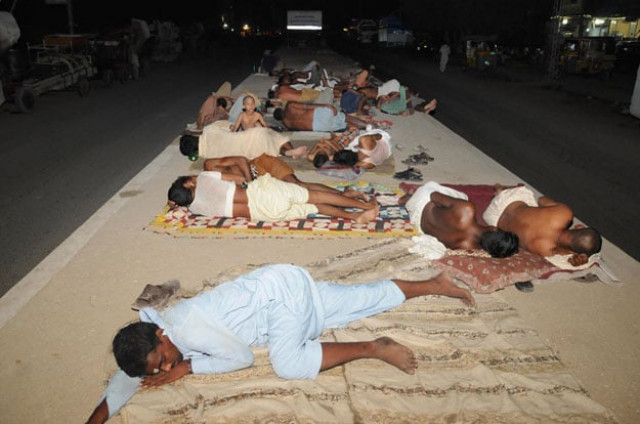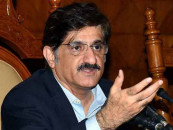The load-shedding saga: K-Electric, still stuck in its ‘trenches’
Power utility has simply refused to see any side other than its own.

People are forced to sleep on footpaths due to frequent power outages in Karachi. PHOTO: MOHAMMAD NOMAN/EXPRESS
When Karachi took to the street and protested against prolonged power outages, there was one group of consumers that didn’t feel the heat to complain.
Putting aside other pending concerns including water and gas shortage, the half a dozen industrial estates, armed with thousands of factories and heavy-duty equipment, continued to get uninterrupted power supply.
This is probably, more than anything else, a good sign for the economy and the logical course for K-Electric’s operational efficiency. Is it not?
The power utility, mainly responsible for serving the metropolis, has around 2.5 million consumers. Of these, the industrial component of consumers stands at 60,000 or 2.4%, while domestic consumers stand at 1.85 million.
However, when it comes to revenue, these industrial establishments account for 37.8% of what the utility earns - the single largest contributor to its sales, followed by residential consumers.
Read: Subsidy slashed: K-Electric tariff revised upwards by 20% to 80%
So it makes sense to keep businessmen happy. They pay their bills on time and its not easy for them to vanish overnight. Most importantly, their tariff is the highest - which means more revenue per incremental sale of unit.
In addition, managing and serving this small clientele is easier. K-Electric needs a limited set of resources, from equipment to customer care representatives, to manage complaints.
The flip side
When one travels to residential areas, already crammed with over bulging population and an eatery practically in every nook and corner, the situation changes.
Imagine a congested Gulstan-e-Jauhar with its thousands of apartments and houses trying to spread across narrow lanes and streets. K-Electric now needs more hands to deliver bills, more rounds to check if electricity meters are not tampered with, more transformers and more of everything else.
Power utilities are monopolies because it does not make economic sense to have two sets of electricity wires running on two separate sets of poles on the street.
But the structure of K-Electric goes beyond this. It is a complete vertically integrated utility - having sway over the system which brings power to homes, the high tension wires that lift electricity from the power plants and power plants themselves.
However, this does not mean the utility has its way. To ensure consumers are not overcharged, state-controlled National Electric Power Regulatory Authority (Nepra) reviews and calculates K-Electric’s expenses, adds a profit margin as dictated by a formula and decides the tariff for different categories of consumers.
It needs to be mentioned that there is not a lot of competition in the electricity generation and supply business. The trend has been for government to seek investment via lucrative guaranteed rate of return offers to investors. This is the reason most IPPs like Hub Power Company are always likely to post a profit.
How K-Electric works
K-Electric works under a separate Multiyear Tariff (MYT) regime, which is a complicated formula consisting of terms like CPI minus X factor of efficiency, claw-back profit sharing and WACI etc. This is basically an outcome of a decision taken in 2002 when the then-government decided to privatise Karachi Electric Supply Company.
To cut the story short, the formula ensures a certain rate of return on the utility’s assets but bounds real earning to efficiency gains. So technically, K Electric has to cut transmission and distribution losses (read theft) and enhance productivity of its power plants if it wants to take home some cash.
And that’s exactly what the company has done.
The switch to gas
The utility has switched almost all its power generators to gas and stopped using oil because gas-fired power plants have higher efficiency. At the same time, it has embarked on a campaign to cut theft come what may.
Read: Power woes: Senate panel to probe casualties in Karachi
In the process, the utility fought battles -with government officials behind closed doors and against public out on the street. It divided Karachi into ‘good’ and ‘bad’ zones on the basis of bill recovery and shifted the burden of power deficit on areas where the theft was high.
All these initiatives were aimed at cutting cost and improving the bottom line. In doing so, K-Electric missed one crucial thing.
Over the years, as people started consuming more, there was a gradual increase in the sale of household electronic appliances - the number of televisions, refrigerators and air conditioners has increased on average.
Now, comes the dreaded summer of 2015 when heat took its (death) toll to over 1,200.
The transformer outside your home was never meant to carry such a load. It was installed sometime in the 1990s to cater to, let’s say, ten homes with each having four fans, an equal number of tube lights, a fridge and a television. As incomes grew, load on that PMT also rose. The collapse was waiting to happen.
But this does not mean K-Electric did not invest in this area. When Abraaj Capital bought controlling stake in the company in 2009, it injected $361 million, part of which was used to build a new power plant.
The first time Tabish Gauhar, now the K-Electric chairman, interacted with media, he did not say much. Reporters bombarded him with scathing questions and he sat quietly, hand clenched tightly before his face, sweat dripping down his temples.
A few months later, he led the charge against 7,000 agitating employees who were forced to take a golden handshake. The utility’s office and management was attacked but Gauhar and his team did not cave.
In 2013, the team published a book “From the trenches: A real life perspective on real life issues” that spoke about difficulties the management went through in its turnaround.
The theme that ran throughout the book was ‘how wrong everyone else can be and how right we were.’ As things stand today, this misplaced sense of righteousness has transcended down to every junior executive of the utility. It is reflected in their attitude when they hear complaints of even an overcharged bill.
The senior management management has resorted to what appears to be like corporate militancy against its own consumers, blaming them time and time again for all that is wrong with the power system in the port city. But Gauhar must not forget that this particular summer, even the word tragedy would be an understatement. It will take many years before the ghosts of over 1,200 stop haunting the management that just isn’t ready to accept even part of the blame.
Published in The Express Tribune, July 4th, 2015.
Like Business on Facebook, follow @TribuneBiz on Twitter to stay informed and join in the conversation.



















COMMENTS
Comments are moderated and generally will be posted if they are on-topic and not abusive.
For more information, please see our Comments FAQ